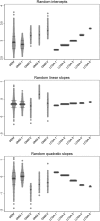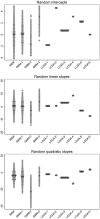Identifying typical trajectories in longitudinal data: modelling strategies and interpretations
- PMID: 32140937
- PMCID: PMC7154024
- DOI: 10.1007/s10654-020-00615-6
Identifying typical trajectories in longitudinal data: modelling strategies and interpretations
Abstract
Individual-level longitudinal data on biological, behavioural, and social dimensions are becoming increasingly available. Typically, these data are analysed using mixed effects models, with the result summarised in terms of an average trajectory plus measures of the individual variations around this average. However, public health investigations would benefit from finer modelling of these individual variations which identify not just one average trajectory, but several typical trajectories. If evidence of heterogeneity in the development of these variables is found, the role played by temporally preceding (explanatory) variables as well as the potential impact of differential trajectories may have on later outcomes is often of interest. A wide choice of methods for uncovering typical trajectories and relating them to precursors and later outcomes exists. However, despite their increasing use, no practical overview of these methods targeted at epidemiological applications exists. Hence we provide: (a) a review of the three most commonly used methods for the identification of latent trajectories (growth mixture models, latent class growth analysis, and longitudinal latent class analysis); and (b) recommendations for the identification and interpretation of these trajectories and of their relationship with other variables. For illustration, we use longitudinal data on childhood body mass index and parental reports of fussy eating, collected in the Avon Longitudinal Study of Parents and Children.
Keywords: ALSPAC; Growth mixture models; Latent class growth analysis; Longitudinal latent class analysis; Mixed effects models.
Conflict of interest statement
Bulik reports: Shire (Scientific Advisory Board member), Idorsia (Consultant), and Pearson (author, royalty recipient). All others authors declare no conflicts of interest.
Figures









References
-
- Verbeke G, Molenberghs G. Linear mixed models for longitudinal data. In: Fitzmaurice GM, Laird NM, Ware JH, editors. Applied longitudinal analysis. Berlin: Springer; 2000.
-
- Goldstein H. Multilevel statistical models. 4. London: Arnold; 2011.
-
- Audrain-McGovern J, et al. Identifying and characterizing adolescent smoking trajectories. Cancer Epidemiol Biomark Prev. 2004;13(12):2023–2034. - PubMed
Publication types
MeSH terms
Grants and funding
LinkOut - more resources
Full Text Sources
Medical

